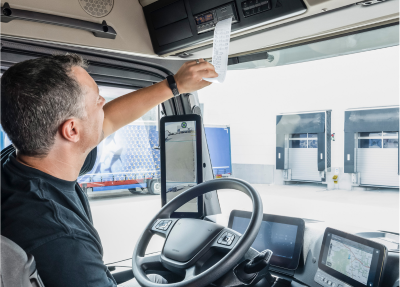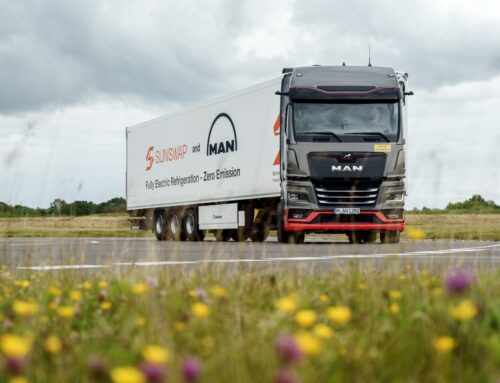Warning over tacho retrofit ‘bottleneck’ this year
Tachograph experts have advised UK fleets with heavy vehicles that are driven abroad, but which are currently not fitted with ‘smart’ tachographs, to book in their retrofits of second-generation smart tachos well ahead of the 31 December 2024 deadline – in order to help avoid a ‘bottleneck’ situation later this year as tacho centres face heavy demand.
The rollout of the version 2 smart tachographs, which incorporate increased functionality and security, is a requirement of European Union mobility laws, and vehicles that only operate in the UK do not require a retrofit.
But for goods vehicles over 3.5 tonnes and passenger vehicles with 10 or more seats that operate internationally, which currently have an analogue or ‘non-smart’ digital tachograph, a version 2 smart tachograph must be retrofitted by 31 December this year.
“We have real concerns about the capacity of the calibration stations to handle this level of additional demand for retrofits,” said Karen Crispe, director at compliance platform provider Convey Technology.
Though there is some uncertainty around the enforcement strategies that individual EU member states will adopt, consequences for non-compliance could be significant, Convey has warned.
Attendees of a special webinar hosted by the company last month heard from a Driver & Vehicle Standards Agency (DVSA) representative that it was possible those caught with non-compliant tachographs abroad may be required to proceed to a local tacho centre for a retrofit at their expense, in addition to a potential fine.
This, it was suggested, would be DVSA’s approach to non-compliant foreign-based vehicles operating in Great Britain.
Skillray Transport Services UK, which supplies tachograph hardware from both of the major manufacturers, Stoneridge and Continental, also raised concerns.
Skillray told Transport Operator: “We envisage supply chain issues with parts at the height of the retrofits, as this is for the whole of Europe and our information is that all countries are facing the same issues. As a key supplier we’re doing all we can to prevent any issues, but only starting early will prevent the bottleneck that is going to happen with workshop availability.”
Retrofitting tachograph parts can take up to three hours, the company says, while slot availability at main dealers has become limited due to the industry shortage of technicians.
Tachograph centres have told Skillray they have limited capacity to complete the retrofits, the firm reports – possibly as few as two or three per day – on top of their usual work of calibrations, which tachographs require every two years.
“We have seen mandatory retrofits in the tachograph industry before back in 2008 for all 3.5t vehicles that fell into scope; parts and availability were a massive problem then also,” said Skillray.
Stuart West, product and marketing manager at Continental which manufactures VDO brand tachographs, told Transport Operator: “Continental have been advising both fleets and workshops over the past few months through various communication channels to consider retrofitting the smart tachograph version 2 on those vehicles which will be affected by the new rules on their next calibration date, rather than waiting until the end of 2024 (if their next calibration date is due before the end of 2024).
“International fleets that fail to act or leave it too late could risk their vehicles being unable to travel cross border, or if doing so with the wrong tachograph can face penalties from the local authority of that country, which could include significant fines and vehicles being immobilised.”
He continued: “Fleets and workshops taking this proactive approach to retrofitting will help reduce the fear over stock availability or any potential delays in getting booked into a workshop for the retrofit. Continental are working closely with our partners to try and ensure there is enough stock available for the next few key dates in the EU Mobility Package 1, both throughout 2024 and beyond.”
Internationally operating in-scope vehicles currently fitted with a first-generation (version 1) smart tachograph will also need to be retrofitted, but have longer to comply, until August 2025. From July 2026, an estimated 48,000 vehicles lighter than the current 3.5-tonne threshold, but over 2.5 tonnes, will also fall into scope for international travel.
 Convey Technology’s webinar in February, chaired by Karen Crispe, brought together experts to discuss and answer questions about the enforcement of the new mobility rules, supply of the tachographs, and retrofitting in calibration stations.
Convey Technology’s webinar in February, chaired by Karen Crispe, brought together experts to discuss and answer questions about the enforcement of the new mobility rules, supply of the tachographs, and retrofitting in calibration stations.
During the session, Laurent Duclos, importers support manager at Stoneridge, said that the two main manufacturers had been producing an estimated 500,000 first-generation smart tachographs per year between 2019 and 2023, but that the European Commission had estimated that over 1.5 million vehicles must be retrofitted with ‘smart 2’ tachos by August 2025 – more than three times that volume.
“In that respect, Stoneridge did build up capacity in terms of production; we are ready to service the market,” he said.
But the firm did foresee a bottleneck scenario “which will be in the planning of those retrofits”.
He reiterated the call for operators to “anticipate” this when it came to booking in retrofits at workshops.
Andrew Wright, director at Skillray, estimated that more than 13,500 vehicles in the UK might need new tachographs by 31 December this year, and a further 7,900+ by the following August – meaning overall potential UK retrofit sales could exceed 21,500 by 2025.
He went on to provide analysis of UK tachograph centre capacity; there were more than 700 tachograph centres in total, but around 130 of these were either inactive, only dealt with new vehicles or only had a single technician.
With slot availability limited at many of the remaining sites, Skillray’s estimate was that the total capacity for installations nationwide was around 166 per day.
“Currently today we have very little movement on fleets retrofitting to the latest smart 2 tachograph,” he warned, based on Skillray’s own sales figures.
Main dealers, which comprise the bulk of active tacho centres, “currently have staffing issues across the industry,” he added, while fleets with in-house tachograph centres were mainly concerned with their own vehicles’ calibration and completed little outside work. Therefore, the main bulk of the retrofitting would be completed by independent tacho centres.
He suggested that swift action in raising awareness with hauliers would help avoid problems, adding that September 2024 should be regarded as the point by which to complete installations – since from October to December, “Skillray does not think there will be enough available slots to retrofit vehicles within the UK”.
During the webinar, Karen Crispe said Convey had consulted a sample poll of a number of its own international customers, and warned that the level of awareness around the potential impact of the situation was “very low”.
Asked what repercussions UK operators entering Europe without the right tachograph could face, DVSA’s enforcement policy officer Spencer Miller said: “We don’t set the fines and sanctions for other countries, so it’s really difficult. But what I can tell you is that if it happens the other way round – if a vehicle comes into the UK with the wrong type of tachograph – it’ll be a £300 fixed penalty.
“But the tricky part is, it will be sent to a tachograph centre there and then, to have the new one fitted… They won’t get their favourable rate which they get with their own tachograph centre… We need to start now, really, to try and avoid it.”
In response to a query from an operator later in the session, he added: “I would guess pretty strongly that [the policy of requiring non-compliant vehicles to be sent for retrofit] will be the same across Europe, because you can’t… impose a penalty and then allow them to continue driving with the same offence.”
The issue is particularly pertinent for Northern Ireland fleets operating in the Republic; and Skillray’s Andrew Wright said efforts had been concentrated here.
“The [tachograph centres] on the border are fully aware of this, and have been contacting operators for the last six months,” he said.
While manufacturers say they will be able to meet current requirements, says Convey, any supply chain disruption could have serious repercussions.
“This is not just a UK issue – these tachos are needed across Europe – we have seen manufacturer projections to show that the potential demand for tachos across Europe could be 1.5 million over the next two years,” said Karen Crispe.
“This is why we are now actively trying to raise awareness of the situation and would urge anyone who operates internationally to get their vehicles retrofitted now to avoid any issues.”
Convey also highlighted the associated financial implications; with retrofits of the smart 2 tachos costing approximately £1,000, fleets that have not budgeted for the outlay could see significant unplanned costs, it warned – but added that the cost of non-compliance could be far higher.
The rollout of smart 2 tachos has already seen delays as regards their installation in newly registered vehicles, with an original deadline of 21 August 2023 extended to last month, due to concerns over smart 2 tacho availability.
Continental’s Stuart West added: “Continental will continue to support all its partners and keep their dedicated websites up to date as well as emailing workshops and fleets with regular developments.
“Continental have introduced a new online eLearning platform with an array of free courses for drivers on the new smart tachograph version 2, and have recently set up a Facebook community for drivers and fleets aimed at supporting International operators with everything, from advising on the different rules across Europe to how some of the changes can affect them.”











